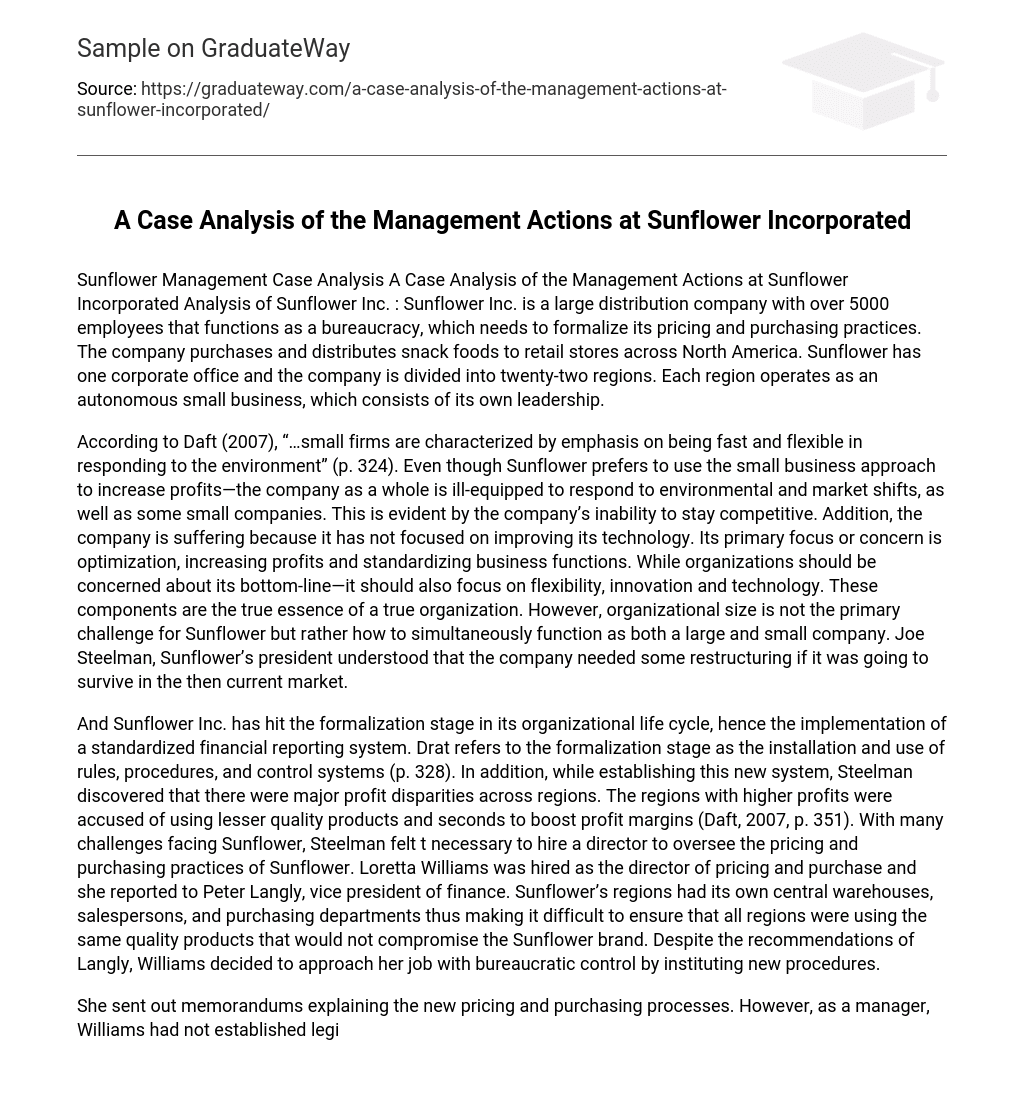Sunflower Management Case Analysis A Case Analysis of the Management Actions at Sunflower Incorporated Analysis of Sunflower Inc. : Sunflower Inc. is a large distribution company with over 5000 employees that functions as a bureaucracy, which needs to formalize its pricing and purchasing practices. The company purchases and distributes snack foods to retail stores across North America. Sunflower has one corporate office and the company is divided into twenty-two regions. Each region operates as an autonomous small business, which consists of its own leadership.
According to Daft (2007), “…small firms are characterized by emphasis on being fast and flexible in responding to the environment” (p. 324). Even though Sunflower prefers to use the small business approach to increase profits—the company as a whole is ill-equipped to respond to environmental and market shifts, as well as some small companies. This is evident by the company’s inability to stay competitive. Addition, the company is suffering because it has not focused on improving its technology. Its primary focus or concern is optimization, increasing profits and standardizing business functions. While organizations should be concerned about its bottom-line—it should also focus on flexibility, innovation and technology. These components are the true essence of a true organization. However, organizational size is not the primary challenge for Sunflower but rather how to simultaneously function as both a large and small company. Joe Steelman, Sunflower’s president understood that the company needed some restructuring if it was going to survive in the then current market.
And Sunflower Inc. has hit the formalization stage in its organizational life cycle, hence the implementation of a standardized financial reporting system. Drat refers to the formalization stage as the installation and use of rules, procedures, and control systems (p. 328). In addition, while establishing this new system, Steelman discovered that there were major profit disparities across regions. The regions with higher profits were accused of using lesser quality products and seconds to boost profit margins (Daft, 2007, p. 351). With many challenges facing Sunflower, Steelman felt t necessary to hire a director to oversee the pricing and purchasing practices of Sunflower. Loretta Williams was hired as the director of pricing and purchase and she reported to Peter Langly, vice president of finance. Sunflower’s regions had its own central warehouses, salespersons, and purchasing departments thus making it difficult to ensure that all regions were using the same quality products that would not compromise the Sunflower brand. Despite the recommendations of Langly, Williams decided to approach her job with bureaucratic control by instituting new procedures.
She sent out memorandums explaining the new pricing and purchasing processes. However, as a manager, Williams had not established legitimate authority. Like many managers, Williams had difficulty implementing her decision making processes because she irrationally judged everything based on outcomes. William’s critical mistaken was not establishing relationships with regional top managers as suggested by Langly. Larry Bossidy and Ram Charan states in their book, Execution: The Discipline of Getting Things Done, that organizational success is found in the details (Daft, 2007, p. 25). Williams should have considered studied Sunflower’s organizational culture and utilized the basic building blocks of execution: know your people and business, confront problems head-on, and set clear goals. According to Harrison (1999), the ideal decision making process some sets such as setting managerial objectives, and asking questions such as what do we want to achieve in the process? Sunflower Inc. integrated a market control system that may have been allowed managers can compare prices and profits to evaluate the efficiency of their regions (Daft, 2007, p. 40). This process would have involved a detailed and objective analysis of the company’s quality regulations and its ability to maximize its market opportunities. “Execution is not simply getting things done; it means understanding the elements that have to be in place in order to get things done” (Daft, 2007, p. 325). Daft, R. L. , (2007) Organizational theory and design, 9th ed. Mason, OH: Thomson South-Western. Harrison, E. F. (1999). The managerial decision making process, 5th ed. Boston: Houghton Mifflin.





